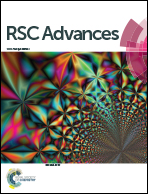Polyethylenimine modified magnetic graphene oxide nanocomposites for Cu2+ removal
Abstract
Fe3O4 nanoparticles were synthesized on graphene oxide (GO), then mixed with polyethylenimine to obtain GO/Fe3O4/PEI nanocomposites. Due to the high surface area of GO, superparamagnetism of Fe3O4, and excellent complex ability of PEI, the nanocomposites showed extremely high Cu2+ removal efficiency. The Cu2+ removal capacity was 157 mg g−1, which is higher than most reported results. The adsorption kinetics could be best described by a pseudo-second-order model. Moreover, GO/Fe3O4/PEI nanocomposites could be easily recycled by magnetic separation. After five cycles, the removal efficiency remained 84%.


 Please wait while we load your content...
Please wait while we load your content...